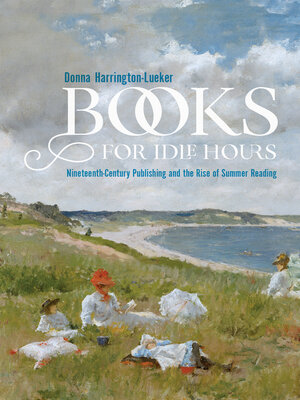Books for Idle Hours
ebook ∣ Nineteenth-Century Publishing and the Rise of Summer Reading
By Donna Harrington-Lueker

Sign up to save your library
With an OverDrive account, you can save your favorite libraries for at-a-glance information about availability. Find out more about OverDrive accounts.
Find this title in Libby, the library reading app by OverDrive.



Search for a digital library with this title
Title found at these libraries:
| Library Name | Distance |
|---|---|
| Loading... |
"A fascinating study" of the nineteenth-century roots of beach books and summer reads—and the public disapproval that failed to stop the enjoyment of them (New England Quarterly).
The publishing phenomenon of summer reading, often focused on novels set in vacation destinations, started in the nineteenth century, as both print culture and tourist culture expanded in the United States. As an emerging middle class increasingly embraced summer leisure as a marker of social status, book publishers sought new market opportunities, authors discovered a growing readership, and more readers indulged in lighter fare.
Drawing on publishing records, book reviews, readers' diaries, and popular novels of the period, Donna Harrington-Lueker explores the beginning of summer reading and the backlash against it. Countering fears about the dangers of leisurely reading—especially for young women—publishers framed summer reading not as a disreputable habit but a respectable pastime and welcome respite. Books for Idle Hours sheds new sunlight on an ongoing seasonal tradition.
"Books for Idle Hours is especially interesting on the emergence of a new type of textual diversion: the American summer novel . . . it takes these books—and the culture that shaped them, and the culture they shaped—seriously, even while acknowledging how transitory they were." —The New Yorker
"A fascinating study of a distinct but largely overlooked body of nineteenth-century American fiction and the authors, readers, publishers, and economic and social conditions that gave rise to it." —New England Quarterly
"Incisive commentary on the relationship between market forces and readers' tastes . . . As enjoyable as it is informative." —Reception
The publishing phenomenon of summer reading, often focused on novels set in vacation destinations, started in the nineteenth century, as both print culture and tourist culture expanded in the United States. As an emerging middle class increasingly embraced summer leisure as a marker of social status, book publishers sought new market opportunities, authors discovered a growing readership, and more readers indulged in lighter fare.
Drawing on publishing records, book reviews, readers' diaries, and popular novels of the period, Donna Harrington-Lueker explores the beginning of summer reading and the backlash against it. Countering fears about the dangers of leisurely reading—especially for young women—publishers framed summer reading not as a disreputable habit but a respectable pastime and welcome respite. Books for Idle Hours sheds new sunlight on an ongoing seasonal tradition.
"Books for Idle Hours is especially interesting on the emergence of a new type of textual diversion: the American summer novel . . . it takes these books—and the culture that shaped them, and the culture they shaped—seriously, even while acknowledging how transitory they were." —The New Yorker
"A fascinating study of a distinct but largely overlooked body of nineteenth-century American fiction and the authors, readers, publishers, and economic and social conditions that gave rise to it." —New England Quarterly
"Incisive commentary on the relationship between market forces and readers' tastes . . . As enjoyable as it is informative." —Reception







